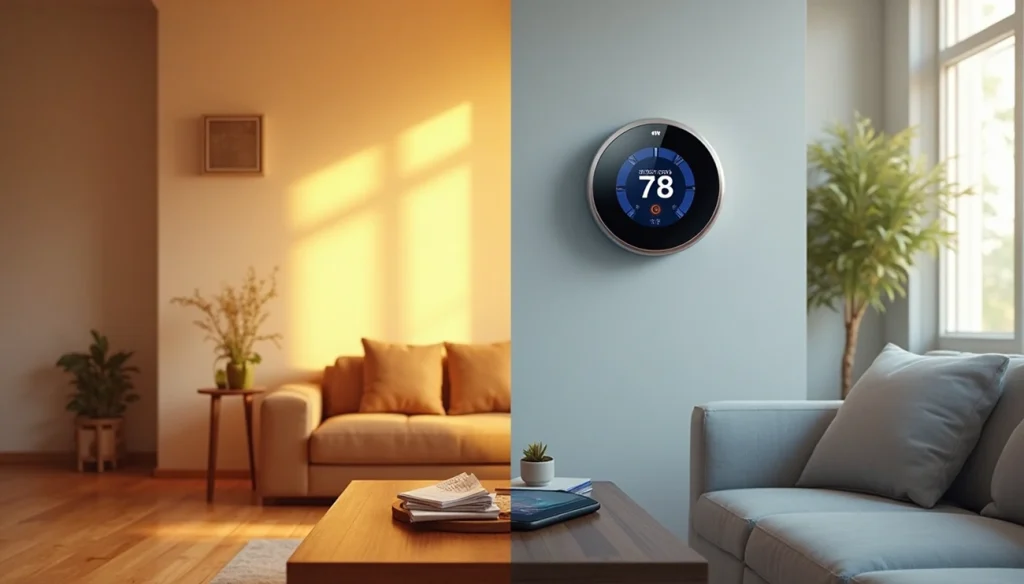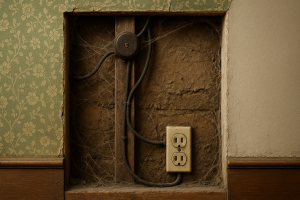Want to cut your utility bills by up to 20% each year? A smart thermostat might be your answer.
The typical American household spends nearly half its yearly energy costs on heating and cooling—that’s over $900 annually. You could save $140-$150 in just one year by installing an energy-saving thermostat, assuming your monthly energy bill is around $150. The U.S. Department of Energy backs this up, showing homeowners typically save 8-10% on heating and cooling costs with these devices. Smart thermostats do more than just save money. They make your home more comfortable, convenient, and environmentally friendly. These devices could help America avoid 6.91 gigatons of carbon dioxide emissions and save $1.78 trillion in lifetime energy costs if more people used them.
Let’s explore how smart thermostats save energy through their intelligent features, proper setup, and available incentives to help you get the most value from your investment.
What Is a Smart Thermostat and How Does It Work?
A smart thermostat connects to WiFi and adjusts your home’s heating and cooling settings automatically. These devices do much more than regular thermostats because they link to your home’s internet network.
Remote access and app control
Smart thermostats give you complete control of your home’s climate system through smartphone apps. The dedicated mobile apps let you:
- Change and check temperature settings from any location with internet
- Get alerts if temperatures go above or below your set limits
- See notifications about filter changes and maintenance needs
- Check indoor humidity and outdoor temperature
- Look at 5-day weather forecasts to plan ahead
This remote access helps when you leave home without adjusting settings or want your house comfortable before you return. People with mobility issues benefit greatly as they can adjust temperatures without walking to the thermostat.
Learning your schedule and priorities
Smart thermostats stand out because they learn from what you do and adapt. The thermostat starts to understand your priorities after you make manual adjustments for a while.
These devices use machine learning algorithms to watch your temperature changes throughout the day. They create a customized heating and cooling schedule that matches your lifestyle. To cite an instance, see the Nest Learning Thermostat – it takes about 10 days to build your complete schedule.
The learning process works by:
- Recording your temperature changes at specific times
- Finding patterns in how you use the system
- Adding these settings to your schedule automatically
The thermostat keeps improving its approach to optimize heating and cooling without needing you to make changes.
Geofencing and motion detection
Geofencing uses GPS technology to create an invisible boundary around your house. Your thermostat changes settings automatically when your smartphone crosses this boundary.
Your thermostat can make these changes when you go beyond the geofence (usually 3 miles from home):
- Drop heating temperatures by 3 degrees
- Raise cooling temperatures by 3 degrees
The system returns to your comfort settings before you get back home once you cross the boundary again.
Most smart thermostats include motion and occupancy sensors to see which rooms people use. These sensors save energy by adjusting temperatures based on immediate occupancy instead of fixed schedules.
Your smart thermostat works as a detailed energy management system that saves energy while making life easier. It learns what you like, sees when rooms are in use, and responds to your location to create a smart climate system that keeps you comfortable and reduces energy bills.
Top 5 Features That Help You Save Energy
Smart thermostats can save you money through advanced features that cut energy use while keeping you comfortable. These devices will reduce your heating and cooling costs by 10-15% on average. Some manufacturers claim savings up to 26%.
Automatic scheduling
Smart thermostats have changed the way HVAC systems work by creating customized temperature schedules that match your lifestyle. Traditional programmable thermostats follow fixed schedules whatever the occupancy. Smart thermostats learn and adapt to your habits.
These devices remember your temperature priorities and create schedules that switch to energy-saving temperatures when you sleep or leave. Most models watch how you adjust the temperature for several days. They spot patterns in your behavior to build the best heating and cooling routine without constant adjustments.
This smart scheduling won’t waste energy on an empty home. Your home stays comfortable when you’re there – a key way to lower those monthly utility bills.
Eco mode and temperature setbacks
The most effective way to save energy comes from Eco mode, which uses temperature “setbacks” – planned temperature changes at specific times. The Department of Energy says you can save up to 10% yearly by setting back temperatures 7-10 degrees for eight hours each day.
Eco mode adjusts your home’s temperature within these ranges:
- Heating mode: 40-70°F (4-21°C)
- Cooling mode: 76-90°F (24-32°C)
These devices handle setbacks through several methods:
- They detect when you leave through sensors or geofencing
- They know when you sleep based on your patterns
- They let you set vacation modes for long trips
Your system still kicks in if temperatures hit extremes, which stops pipes from freezing in winter or excessive heat in summer.
Energy usage reports
Today’s smart thermostats give you detailed reports that help you learn about your home’s energy use. These interactive reports show:
- Visual breakdowns of system runtime hours
- How heating and cooling use changes month to month
- Humidity level tracking and analysis
- How your efficiency ranks against nearby homes[112]
These reports help you spot usage patterns, find waste, and make better decisions about your settings. Some models suggest schedule changes based on your data, helping you save more money while staying comfortable.
Integration with smart home systems
Smart thermostats work best when connected to other smart devices in your home. This connection creates a team of devices working together to save energy.
To cite an instance, connecting your thermostat to smart blinds helps control indoor temperatures naturally. The blinds block sun on hot days or let in warmth during cold spells. Smart lighting or occupancy sensors can also help create a complete energy management plan.
Many thermostats work with utility companies’ demand response programs. They adjust during peak energy times to reduce grid strain and might save you extra money.
Voice assistant compatibility
Voice control makes your smart thermostat both convenient and energy-efficient. These thermostats work with popular voice assistants like Amazon Alexa and Google Assistant for hands-free control.
Voice control gives you:
- Quick temperature changes without using apps
- Fast activation of energy-saving modes
- Temperature control from anywhere within voice range
Ecobee Premium has a built-in smart speaker that eliminates the need for separate devices while offering the same voice controls.
How Much Can You Actually Save?
At the time you’re buying a smart thermostat, the bottom-line question is simple: how much money will you actually save? Let’s get into the real numbers behind smart thermostat energy savings.
Average savings per year
Reputable sources agree on meaningful but varied savings potential. ENERGY STAR says certified smart thermostats save households about 8% on heating and cooling costs annually—about $50 per year.
Studies from manufacturers paint an even better picture:
- Nest shows average savings of 10-12% on heating and 15% on cooling, which adds up to $131-$145 annually
- Ecobee says users can save up to 26% on heating and cooling costs, maybe even reaching $200 in yearly savings [183]
The sort of thing I love is that some utility companies found smart thermostat features can lower energy costs by up to 20% annually. To put this in context, heating and cooling make up nearly half of a household’s yearly energy bill—more than $900—so these percentages mean real money in your pocket.
Does a smart thermostat save money?
Yes—but your actual savings depend on several factors:
- Climate zone: Homes in areas with extreme temperatures or higher energy rates save more
- Occupancy patterns: Empty houses benefit more from automated temperature changes
- Home size and insulation: Bigger or poorly insulated homes can save more
- Current thermostat habits: If you already adjust temperatures often, you might save less
The Department of Energy says setting your thermostat back 7-10 degrees Fahrenheit for 8 hours daily can cut heating and cooling bills by up to 10%. Smart thermostats handle these adjustments automatically—even when you forget.
Most smart thermostats ended up paying for themselves within 1-2 years through energy savings alone. With their typical lifespan of 10+ years, that’s excellent long-term value.
Real-life examples from homeowners
Real people’s experiences often confirm what manufacturers claim. One Duke Energy customer said: “There are so many times I have left the house without turning the temp down from overnight, and I can fix that remotely instead of having to leave it all day”.
There’s another reason from a homeowner about vacation benefits: “The last time we went on vacation, and we got about halfway there, I realized ‘I forgot to turn the unit back down.’ I was able to just pull out my phone and put the unit up so that the AC wouldn’t come on unless it was 85”.
Consumer Reports found something interesting: smart thermostat owners keep the same average temperature (72°F) as those with regular thermostats but save more by managing temperatures better when they’re away. You can stay comfortable and still cut costs.
Duke Energy’s demand-response program gives customers at least $75 in bill credits after signing up plus $25 yearly for staying in the program—adding extra savings beyond regular efficiency improvements.
Choosing the Right Smart Thermostat for Your Home
Smart thermostats can help you save energy, but you must think over several technical factors before buying one. Your home setup needs a compatible device that maximizes energy savings.
Check HVAC system compatibility
Your heating and cooling system must work with your chosen smart thermostat. Most smart thermostats work well with conventional forced air, heat pumps, and dual-fuel systems. They might have some limitations with radiant systems or proprietary setups.
The main compatibility factors include:
- Voltage requirements – Smart thermostats usually work with 24V systems, not 120V or 240V high-voltage systems in electric baseboards
- C-wire availability – Most models just need a common wire that provides continuous power
- Multi-stage systems – Your thermostat should support your specific setup
Manufacturers provide online compatibility checkers that make this process easier. Professional installation works best with unique setups like dual-fuel systems that combine a heat pump with furnace.
Compare ENERGY STAR certified models
Independent testing verifies that ENERGY STAR certified smart thermostats save energy based on field data. These models meet specific performance standards:
- They reduce heating runtime by at least 8%
- They reduce cooling runtime by at least 10%
- They work with utility demand response programs
Pick features that match your needs – remote access, geofencing, or detailed energy reports.
Wi-Fi and app requirements
A reliable internet connection makes your smart thermostat work better. Place your device close enough to your router to maintain connection. You might want a Wi-Fi range extender if the signal seems weak at the thermostat location.
The setup process usually involves:
- Getting the manufacturer’s mobile app
- Adding your Wi-Fi network details
- Setting up an account that enables remote access
Installation tips for beginners
Many homeowners can install smart thermostats without help. Here’s what you should do first:
- Switch off your HVAC system’s power at the circuit breaker
- Take pictures of current wiring before you disconnect anything
- Label all connections with provided wire markers
- Look for a C-wire or get adapter kits if you don’t have one
Complex systems like zoned heating/cooling or multi-stage equipment might need professional installation to work properly.
Maximize Savings with Utility Programs and Incentives
Smart thermostats are energy efficient by design, and you can save even more money by teaming up with your utility company through special programs and incentives.
Enroll in demand response programs
Your electricity provider and you can both benefit from demand response programs. These optional programs let utilities adjust your thermostat settings briefly during peak usage times—usually on hot summer days when power grids are under stress.
Your utility company might reward you with:
- $50-$70 credits just for signing up
- $5 monthly credits per thermostat
- $10-$35 yearly rewards if you keep participating
You can expect 30-45 energy events throughout the year. Each event lasts 2-4 hours and we scheduled them mostly in summer between 6:00 a.m. and 10:00 p.m. Small temperature changes (usually 3-4 degrees higher) help balance the power grid and lower your energy bills.
Get rebates from your energy provider
You can cut down your original investment with direct rebates on ENERGY STAR certified smart thermostats from most utility companies. These rebates can range from $22 to $100 based on where you live and your energy provider.
You’ll just need these things to get your rebate:
- An active residential account with your utility company
- Proof of purchase (receipt with date and model number)
- Submit everything within 90-120 days of purchase[252]
Some utilities make it easier by offering instant discounts through their online stores or retail partners, so you don’t have to wait for rebate processing.
Understand eligibility and opt-out options
Each utility has different rules, but here are common requirements:
- You must have an active residential account
- You need to own your smart thermostat (not lease it)
- Your device must have a continuous connection to WiFi
You retain control over your comfort level. Most programs let you skip specific events by adjusting your temperature manually. In spite of that, skipping too many events might reduce your rewards—some programs require you to participate in at least 75% of events to get full benefits.
These programs are optional, but some might charge an early termination fee ($50) if you leave before your original contract ends.
Conclusion
Smart Thermostats: Your Path to Energy Savings
Smart thermostats are one of the best investments homeowners can make to reduce energy consumption. This piece shows how these devices can cut heating and cooling costs by 8-20% each year. You could save $50-$200 annually based on your home’s setup.
Your actual savings depend on your climate zone, home size, occupancy patterns, and how you use your current thermostat. Most homeowners get back their original investment within 1-2 years. This makes smart thermostats a smart choice for long-term savings.
These devices come packed with features that work together to optimize your HVAC system while keeping you comfortable. Smart scheduling, eco mode, energy reports, smart home integration, and voice control are standard features. Remote access and automated adjustments based on your priorities make these devices even more valuable.
Check your HVAC system’s compatibility before buying a smart thermostat. Look at voltage requirements and C-wire availability. ENERGY STAR certified models meet proven performance standards that you should think over during selection.
Working with your utility company helps maximize savings. Rebates between $22-$100 lower your upfront costs. Demand response programs give you $5-$35 yearly incentives when you allow small temperature changes during peak usage times.
Smart thermostats are a perfect solution that works for everyone. They cut energy bills, boost comfort levels, and make life easier through automation. These devices also help the environment by reducing carbon emissions. The real question isn’t whether to upgrade – it’s which model fits your home and lifestyle best.





